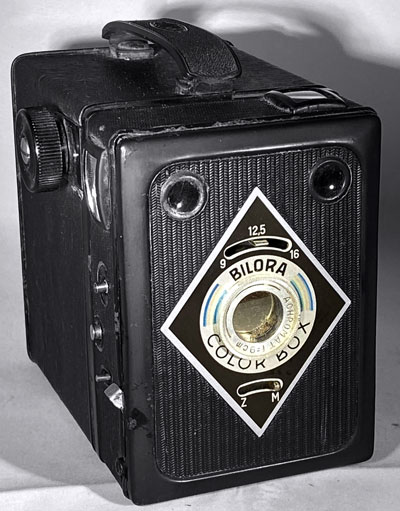Bilora Color Box
Specification

| Manufacturer | : | Bilora |
|---|---|---|
| Produced | : | 1949 |
| Classification | : | Medium Format |
| Body Type | : | Box |
| Construction | : | Metal |
| Film Type | : | 120 |
| Film Width | : | 62mm |
| Image Size | : | 2¼ x 3¼ in |
| No. of Images | : | 8 |
| Lens Type | : | Achromat Meniscus |
| Focal Length | : | 90mm |
| Focus Type | : | Fixed |
| Focus Range | : | 10ft to inf |
| Aperture Type | : | Variable Iris |
| Aperture | : | f/9 to f/16 |
| Shutter Type | : | Rotary |
| Shutter Speeds | : | B,I*(1/50 sec) |
| Size (w x h x d) | : | 85 x 115 x 125mm |
| Weight | : | 520g |
| * Measured on this camera | ||
Art Deco Credentials
![]()
![]()
![]()
Noteworthy: Worth giving special attention
- Produced after the main Art Deco period;
- Diamond shaped decoration on front panel;
- Coloured arcs around lens;
- Raised linear pattern on the winder;
- Chevron pattern on leatherette;
- Symmetrical pattern on face.
Description
The Bilora Color Box camera was manufactured by the Kurbi & Niggeloh Company of Radevormwald/RHLD, Germany. This camera is capable of capturing 6 X 9 cm exposures on no. 120 roll film.
It is made of metal with imitation leather coverings which are embossed with a fine chevron pattern.It has a fixed focus lens with variable aperture settings. It has a simple time and instantaneous shutter. There are two brilliant finders, one for portrait and one for landscape. It has a PC type flash connector. A cable release socket can be found on the front of the shutter release button. Film advance is by red window which has a sliding metal cover.
It has two tripod sockets. A shutter latch is provided to lock the shutter during transport. The camera is opened by pressing on two small chrome buttons on either side.
How to Use
This camera takes 120 film which is easily available from photographic outlets.
As the shutter speed is only 1/50s, it is advisable to use a tripod to get clear shake free images. However, holding it against a wall or other solid object would work as well. For quick snapshots, hold it firmly against your body.
If you don't want to bother with an exposure meter, follow the guide shown. It is based on the 'Sunny 16' rule. Film is so forgiving and will produce acceptable results even when overexposed by 2 or 3 stops or underexposed by 1 stop.
The tables assume that the sun is at least 30 degrees above the horizon - that's 10am - 5pm on a summers day (May - August) in the UK.
The aperture values of 16,12.5 and 9 are indicated on the aperture control.
Remember that the exposure guide in the manual may not be helpful as it is based on the use of old film with a low ISO value.
Using ISO 100/125 film - shutter speed 1/50s
| Weather Conditions | Shadow Detail | Aperture | Exposure |
|---|---|---|---|
 Sunny SunnySnow/Sand | Dark with sharp edges | f/16 | +2 Stops Overexposed Acceptable |
 Sunny Sunny | Distinct | f/16 | +1 Stop Overexposed Acceptable |
 Slight Overcast Slight Overcast | Soft around edges | f/16 | Good |
 Overcast Overcast | Barely visible | f/12.5 | Good |
 Heavy Overcast Heavy Overcast | None | f/9 | Good |
 Open Shade Open Shade/Sunset | None | f/9 | -1 Stop Underexposed Acceptable |